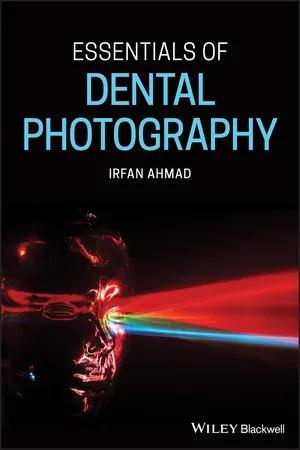
- English
- ePUB (mobile friendly)
- Available on iOS & Android
Essentials of Dental Photography
About This Book
An accessible, one-stop guide to getting the most out of dental photography in clinical practice
Dental photography is an increasingly important part of dental care in general practices, hospitals, and specialist clinics. The uses of dental photographs are numerous, such as monitoring treatment outcomes, educating patients, promoting services, and providing evidence for litigation or regulatory purposes. Essentials of Dental Photography is a user-friendly guide to incorporating dental photographs into daily practice. Containing real-world advice and proven techniques, this book helps clinicians understand and apply the fundamental principles of dental photography.
Accessible chapters cover every major aspect of dental photography and answer the most common questions asked by clinicians. Step-by-step instructions show readers how to select the correct photographic and dental equipment, setup equipment for a variety of dental procedures, process images using photo-editing software, and more. The author, a recognised expert in the field, explain the basic concepts of dental photography and how to create high-quality, predictable and repeatable images. Providing an easy-to-follow roadmap to exceptional dental photographs, this practical guide:
- Covers all the basic concepts, equipment, and techniques of dental photography
- Illustrates the photographic setups for both intra- and extra-oral images
- Provides recommendations for appropriate types of cameras, lenses, flashes, reflectors, tripods, and software
- Discusses photographic archiving, electronic dissemination, printing, publishing, and presenting images
Essentials of Dental Photography is a valuable guide for dental practitioners and new graduates looking to learn dental photography and apply it in practice.
Frequently asked questions
Information
Section 1
Equipment and Concepts

1
Photographic Equipment
‘Which equipment do I need?'‘What is the cost?'‘How long will it take to learn?'
Cameras
Table of contents
- Cover
- Table of Contents
- Foreword
- Preface
- Acknowledgments
- Section 1: Equipment and Concepts
- Section 2: Photographic Set‐ups
- Section 3: Processing Images
- Index
- End User License Agreement